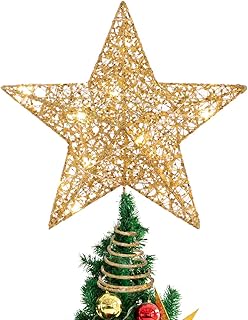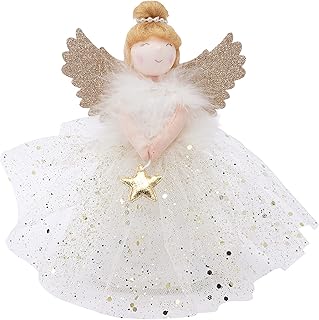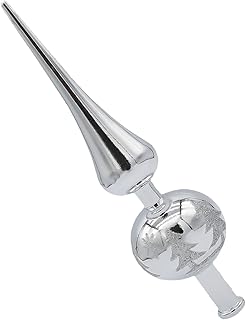Traditional Versus Modern Christmas Tree Toppers: Which Style Best Complements Your Festive Home?
As the festive season draws near, homes throughout the United Kingdom are transformed with twinkling lights, wreaths, garlands, and the cherished centrepiece of Christmas décor: the tree. Each year, decorating the Christmas tree becomes a meaningful family ritual, a moment of togetherness that spans generations. But while baubles, tinsel and fairy lights adorn branches from bottom to top, it is the tree topper that commands attention as the crowning glory—the final flourish, the symbol that catches the eye and frames the entire holiday tableau. The age-old debate over traditional versus modern tree toppers prompts a deeper exploration of what truly makes a home feel festive. Which style best complements your unique space, reflects your family’s character, and captures the spirit of Christmas as you wish to express it? This comprehensive guide delves into the evolution, cultural significance, and creative nuances of both traditional and modern tree toppers, empowering you to make a choice that genuinely enhances your festive home.
The Origins of the Christmas Tree Topper: Tradition at Its Heart
Tree-topping symbols trace their origins back centuries, long before the concept of a “Christmas tree” as we now know it was established. Pagan communities in Europe, eager to welcome the return of light after the winter solstice, would decorate their homes with evergreen boughs, symbols of eternal life. It wasn’t until the sixteenth century in Germany that these boughs began to evolve into full trees, adorned first with apples and edible treats, and later with hand-crafted ornaments and candles.
The tradition of placing an object at the very apex of the tree became widespread in Victorian England. Queen Victoria and Prince Albert, inspired by their German heritage, popularised the decorated tree, positioning it at the heart of Christmas celebrations. During this period, toppers often took the form of religious symbols, such as angels and stars.
The angel, representing the heavenly host announcing Christ’s birth, and the star, recalling the Star of Bethlehem, both became enduring emblems, especially for Christian households. Their presence at the peak of the tree not only expressed faith but also provided comfort, hope, and a link to family traditions. Over time, these icons took on elaborate forms—delicate porcelain angels, glass-blown stars, hand-sewn figures, and velvet rosettes—each carrying a distinct sense of nostalgia.
The Evolution of Tree Toppers: Modernity Meets Meaning
As Christmas celebrations broadened and became more secular in the twentieth and twenty-first centuries, the spectrum of tree toppers expanded dramatically. The modern era brought technological advances and changes in taste, opening the door to an explosion of innovative, unconventional designs. Today’s tree toppers range from illuminated starbursts and rotating LED displays to whimsical figures, geometric forms, witty nods to pop culture, and minimalist shapes crafted from metal, acrylic, or even recycled materials.
This growing diversity reflects broader shifts in society. Many families are seeking ways to personalise their festive décor to reflect a range of beliefs, backgrounds, and creative aspirations. Modern topper trends run the gamut from understated elegance to bold eccentricity. Some choose to echo the sleek lines and neutral colours of contemporary interior design, while others opt for handmade, upcycled, or even high-tech designs that can be controlled via smartphone apps or change colour at the touch of a button.
In the modern home, the tree topper is as much about individual taste, personality, and storytelling as it is about tradition. For those prioritising environmental awareness, toppers crafted from natural materials or family heirlooms carry extra significance. In short, modern tree toppers are shaped by artistry, aesthetics, and the evolving meaning of Christmas itself.
Aesthetics and Atmosphere: What Each Style Reveals About Your Home
Choosing between traditional and modern toppers is more than a matter of taste. Each style brings its own atmosphere to a room, setting the tone for your entire Christmas scheme.
A traditional topper, whether a satin-robed angel, a stained glass star, or a classic bow, tends to evoke feelings of warmth, cosiness, and nostalgia. These toppers are often passed from one generation to the next, gathering memories with each passing year. They pair naturally with classic colour palettes—rich reds, deep greens, golds, and silvers—and complement decorations that recall earlier eras: wooden toys, knitted stockings, velvet ribbons, and heirloom baubles.
In contrast, modern toppers offer an opportunity to express individuality and respond to current design trends. A metallic geometric shape or minimalist star brings a sense of crisp freshness to a room and pairs well with Scandi interiors, monochromatic schemes, or rooms with clean lines and a restrained palette. Modern toppers can be bright and playful as well; a neon sign, a feathered creature, or a character from a beloved film instantly injects personality into the festive display, especially for younger families or creative households.
Ultimately, there is no universal ideal—your choice should resonate with your home’s existing décor, your celebration style, and the mood you wish to set.
People Also Look For:
- TOYANDONA 1PC Christmas Tree Topper Snowman Hugger for Winter Wonderland Party New Year Xmas Tree Decorations Ornament
- Christmas Star Tree Topper, Warm Star Lighted Xmas Tree Toppers Glittered Star-shaped Metal Treetop Snowflake Decorations Projecto...
- Hlimior Pack of 57 Christmas Cake Decorations, Christmas Cake Decoration, Reindeer Cupcake Toppers, Christmas Tree Cake Topper for...
- SONGTIY Christmas Tree Topper Bows, Handmade Bowknot with Christmas Tree and Reindeer, 21.3x11.1 Inches Large Size Xmas Decoration...
- Christmas Tree Topper Christmas Tree Star Silver Glitter Star for Decorations Xmas Tree Decs
Sentiment and Symbolism: What Does Your Topper Mean to You?
In many households, the tree topper is steeped in sentimental value. A porcelain angel once chosen for a grandparent’s tree may resurface each Christmas, linking the present moment with Christmases past. These toppers become family legends, imbued with stories—perhaps one recalls a particularly snowy Christmas, the birth of a child, or a meaningful family reunion.
Traditional toppers often carry overt religious or spiritual symbolism. Stars and angels are reminders of the Christian nativity story but have also acquired wider meanings—guidance, hope, love, and generosity. Even their materials matter: glass symbolises fragility and preciousness; gold denotes light and warmth.
Modern toppers, by contrast, tend to focus on personal expression or fit-for-purpose beauty. They may highlight a family’s sense of humour, a passion for nature, a love of modern art, or a commitment to eco-friendly living. An upcycled topper made from driftwood, recycled glass, or fabric scraps honours sustainability and ingenuity. A bespoke creation from a local artist might celebrate a particular hobby or family tradition.
Deciding which style better complements your home can therefore come down to considering what meaning—or memory—you wish to evoke each time you look at your tree’s apex.
Craftsmanship and Materials: Durability Versus Innovation
Both traditional and modern toppers showcase an impressive array of craftsmanship. Victorian and Edwardian toppers often involved intricate handiwork—hand-painted porcelain, blown glass, or detailed embroidery. These aged pieces, when lovingly preserved, stand as testaments to the skill and artistry of previous generations. They possess a tactile quality and a timelessness that can be difficult to replicate.
Contemporary toppers, meanwhile, have embraced technological and material advancements. LED lights, fibre optics, and sustainable textiles make for toppers that are both dazzling and efficient. Modern methods such as laser cutting and 3D printing have opened up new realms of design, delivering pieces that would have been impossible to construct even a decade ago.
The choice between the two can also involve practical considerations. Traditional toppers may be fragile or heavy, requiring careful placement and storage, while modern versions can be remarkably lightweight and robust. If you have young children, pets, or prefer a tree with slimmer branches (such as the increasingly popular artificial and pre-lit varieties), the practical benefits of a modern design may sway your decision.
Budget and Accessibility: Finding Beauty at Every Price
Today’s market offers toppers at every conceivable price point. Antique or hand-crafted traditional toppers, particularly those crafted by renowned makers or with provenance, may fetch a premium at auctions or vintage shops. However, classic designs are also readily available in high-street retail outlets at reasonable prices.
Modern toppers range from mass-produced options in supermarkets and home décor stores to exclusive, artist-commissioned pieces that serve as investments as well as decorations. The rise of craft culture has also made it easy for anyone, regardless of budget, to create or customise a tree topper using easily sourced materials—ribbons, felt, sequins, driftwood, or recycled containers, for example.
Whether you desire an ornate figure to last a lifetime or a bold statement piece to reflect this year’s trends, there is a topper that aligns with your needs and resources. Often, the most cherished toppers are those made or discovered as a labour of love, irrespective of material value.
Family Traditions: Passing Down the Crown
The ritual surrounding the tree topper can become a treasured family tradition. Many families have a special ceremony for placing the topper, often saving this act for the youngest or oldest member. Stories are told, photographs snapped, and memories recalled.
A traditional topper excels in this setting, evoking the same sense of continuity year after year. However, even modern toppers can become heirlooms in their own right—a handmade felt star crafted by a child, a ceramic bird that marked a particularly joyous Christmas, or a playful object bought on a family trip abroad.
Modern or traditional, it is the story attached to the topper that cements its place in family lore. Some homes delight in collecting new toppers each year, rotating them according to memory or mood. Others stay steadfast, cherishing the reliability of a single beloved adornment.
The Impact of Tree Size and Style on Topper Choice
The size and style of your Christmas tree plays a vital role when deciding between traditional and modern toppers. A grand, bushy real tree with sturdy branches can support even the weightiest of vintage glass stars or angels. In such cases, classic toppers look natural, especially when paired with traditional tree skirts and abundant decorations.
For more modestly sized or artificial trees—particularly slim or pre-lit varieties—lighter, modern toppers may offer a better fit. Geometric, woven, or paper-crafted toppers ensure branches are not overwhelmed, and their streamlined look suits more contemporary interiors.
In open-plan or minimalist homes, a sparer tree decorated with a bold, abstract or metallic topper makes a compelling statement. Conversely, a densely decorated traditional sitting room will be beautifully framed by an opulent, heirloom-worthy angel or star.
Mixing the Old and the New: Creating a Unique Festive Statement
Increasingly, style-conscious households are blending elements from both ends of the spectrum. Mixing old and new can balance tradition with innovation, offering the best of both worlds. A centuries-old angel can be adorned with new ribbons or placed above a modern, colour-themed tree; a graphic wire star might crown a tree decked out with antique trinkets.
The interplay between traditional and modern fosters a sense of layered storytelling—your tree becomes a reflection of your journey as both a family and a host. This approach works especially well for those who enjoy seasonal reinvention, as it allows for evolving displays without losing the thread of continuity that defines Christmas for so many.
Personalisation: The Ultimate in Modernity
The march towards personalised décor has left its mark on the Christmas tree topper. Many families now commission bespoke pieces incorporating names, meaningful motifs, or family crests. Customisation options abound, from monogrammed stars to laser-cut wooden shapes, ornaments made to mimic pets or hobbies, or toppers featuring inside jokes and family slogans.
This move towards personalisation sits firmly in the modern camp, yet it carries an echo of tradition—rooted in the time-honoured desire to make the holiday reflect the household’s unique story.
Tree Toppers Around the World: A Broader Perspective
While the United Kingdom is closely associated with angels and stars, tree toppers vary widely across the globe. In Eastern Europe, intricate woven or straw ornaments—sometimes representing the sun or protective spirits—are popular. Scandinavian nations favour minimalist wooden shapes, heart motifs or red and white figures. In North America, innovation reigns, with trends moving rapidly from one year to the next: everything from model trains to tutus or even tongue-in-cheek pop-culture icons have made appearances at the treetop.
This diversity invites us to consider what really matters: the act of decorating and the meaning we imbue each item with. Whether you draw inspiration from your heritage, travels or current obsessions, your tree topper becomes a small but mighty ambassador for the spirit of your household.
Navigating the Choice: Questions to Consider Before Selecting Your Topper
Choosing the right topper is ultimately about more than ornamentation. Pause to consider what memories and emotions you hope to evoke. Are you seeking comfort and continuity or excitement and novelty? Does faith or heritage play a central role, or is artistry your key motivation? What will draw together the colours, textures, and energy of your other decorations? Is the tree to be admired from afar, or closely inspected by children delighting in every detail?
You might ask yourself whose hands will place the topper. Is it an object for everyone to marvel at, or a personal talisman rich with meaning? Is this year the moment to try something new, or to honour the traditions that shaped your festive memories as a child? There are no right or wrong answers—only the opportunity to create Christmas magic, your way.
Conclusion
The festive tree topper holds a singular place in Christmas celebration, presiding not just over the tree, but over the memories, hopes, and creativity of those who assemble it. Traditional and modern toppers both offer a wealth of style, symbolism, and potential, catering to every home and personality. Whether your heart leans towards nostalgic angels and classic stars, or bold statements and personalised sculptures, your choice is a reflection of your story—a beacon for all who gather beneath its glow.
In the end, the most important element is not the topper’s age, value, or trendiness, but the joy, unity, and meaning it inspires in your festive home. Decorate bravely, blend eras if it suits you, and above all, let the piece that crowns your tree remind you of what the season means to you and those you love.



